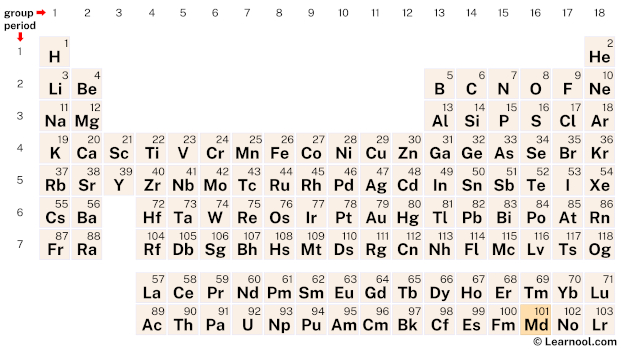
Mendelevium (Md) is a chemical element of the periodic table, located in the period 7, and has the atomic number 101. It is the thirteenth element in the actinide series. It is a silvery-white metal which is named after the Russian chemist Dmitri Mendeleev. It is the ninth transuranium element and is counted as one of the radioactive elements.
On periodic table
| group | ⇨ | 1 | 2 | 3 | 4 | 5 | 6 | 7 | 8 | 9 | 10 | 11 | 12 | 13 | 14 | 15 | 16 | 17 | 18 |
| period | ⇩ | ||||||||||||||||||
| 1 | 1 H  Hydrogen |
2 He  Helium |
|||||||||||||||||
| 2 | 3 Li  Lithium |
4 Be  Beryllium |
5 B  Boron |
6 C  Carbon |
7 N  Nitrogen |
8 O  Oxygen |
9 F  Fluorine |
10 Ne  Neon |
|||||||||||
| 3 | 11 Na  Sodium |
12 Mg  Magnesium |
13 Al  Aluminium |
14 Si Silicon |
15 P  Phosphorus |
16 S  Sulfur |
17 Cl  Chlorine |
18 Ar  Argon |
|||||||||||
| 4 | 19 K  Potassium |
20 Ca  Calcium |
21 Sc  Scandium |
22 Ti  Titanium |
23 V  Vanadium |
24 Cr  Chromium |
25 Mn  Manganese |
26 Fe  Iron |
27 Co  Cobalt |
28 Ni  Nickel |
29 Cu  Copper |
30 Zn  Zinc |
31 Ga  Gallium |
32 Ge  Germanium |
33 As  Arsenic |
34 Se  Selenium |
35 Br  Bromine |
36 Kr  Krypton |
|
| 5 | 37 Rb  Rubidium |
38 Sr  Strontium |
39 Y  Yttrium |
40 Zr  Zirconium |
41 Nb  Niobium |
42 Mo  Molybdenum |
43 Tc  Technetium |
44 Ru  Ruthenium |
45 Rh  Rhodium |
46 Pd  Palladium |
47 Ag  Silver |
48 Cd  Cadmium |
49 In  Indium |
50 Sn  Tin |
51 Sb  Antimony |
52 Te  Tellurium |
53 I  Iodine |
54 Xe  Xenon |
|
| 6 | 55 Cs  Caesium |
56 Ba  Barium |
72 Hf  Hafnium |
73 Ta  Tantalum |
74 W  Tungsten |
75 Re  Rhenium |
76 Os  Osmium |
77 Ir  Iridium |
78 Pt  Platinum |
79 Au  Gold |
80 Hg  Mercury |
81 Tl  Thallium |
82 Pb  Lead |
83 Bi  Bismuth |
84 Po  Polonium |
85 At  Astatine |
86 Rn  Radon |
||
| 7 | 87 Fr  Francium |
88 Ra  Radium |
104 Rf  Rutherfordium |
105 Db  Dubnium |
106 Sg  Seaborgium |
107 Bh  Bohrium |
108 Hs  Hassium |
109 Mt  Meitnerium |
110 Ds  Darmstadtium |
111 Rg  Roentgenium |
112 Cn  Copernicium |
113 Nh  Nihonium |
114 Fl  Flerovium |
115 Mc  Moscovium |
116 Lv  Livermorium |
117 Ts  Tennessine |
118 Og  Oganesson |
||
| 57 La  Lanthanum |
58 Ce  Cerium |
59 Pr  Praseodymium |
60 Nd  Neodymium |
61 Pm  Promethium |
62 Sm  Samarium |
63 Eu  Europium |
64 Gd  Gadolinium |
65 Tb  Terbium |
66 Dy  Dysprosium |
67 Ho  Holmium |
68 Er  Erbium |
69 Tm  Thulium |
70 Yb  Ytterbium |
71 Lu  Lutetium |
|||||
| 89 Ac  Actinium |
90 Th  Thorium |
91 Pa  Protactinium |
92 U  Uranium |
93 Np  Neptunium |
94 Pu  Plutonium |
95 Am  Americium |
96 Cm  Curium |
97 Bk  Berkelium |
98 Cf  Californium |
99 Es  Einsteinium |
100 Fm  Fermium |
101 Md Mendelevium |
102 No  Nobelium |
103 Lr  Lawrencium |
|||||
| – f block |
Mendelevium (Md) is located on the periodic table in the actinide series, which is a group of elements located at the bottom of the table. Specifically, in period 7, between fermium (Fm) and nobelium (No).
Element information
 |
|
| Origin of name | named after Russian chemist Dmitri Mendeleev |
| Symbol | Md |
| Atomic number (Z) | 101 |
| Atomic mass | (258) |
| Block | f-block |
| Period | 7 |
| Classification | Actinide |
| Melting point | 827 ℃, 1521 ℉, 1100 K (predicted) |
| Electron configuration | [Rn] 5f13 7s2 |
| Learn how to write: Mendelevium electron configuration | |
| Electrons per shell | 2, 8, 18, 32, 31, 8, 2 |
| Crystal structure | Face-centered cubic (fcc) (predicted) |
| Phase at r.t | Solid (predicted) |
| Density near r.t | 10.37 g/cm3 (predicted) |
| Natural occurrence | Synthetic |
| Oxidation state | +3 |
| Electronegativity (Pauling scale) | 1.3 |
| Protons Neutrons Electrons |
101 157 101 |
| CAS number | 7440-11-1 |
| Discovered at | Lawrence Berkeley National Laboratory in 1955 |
History

Mendelevium, named after the famous Russian chemist Dmitri Mendeleev, was first synthesized in 1955 by a team of scientists at the University of California, Berkeley, USA. The team was led by Albert Ghiorso and consisted of Glenn T. Seaborg, Bernard G. Harvey, Gregory R. Choppin, and Stanley G. Thompson.
The discovery of mendelevium was part of a larger effort to synthesize heavier elements beyond uranium, which had been achieved only a few years earlier. The team used a cyclotron to bombard a target of plutonium-239 with helium ions, which resulted in the formation of mendelevium-256.
The discovery of mendelevium was a significant achievement in the field of nuclear chemistry and was the first step towards the synthesis of even heavier elements. It was also an important validation of Mendeleev’s periodic table, which had predicted the existence of an element with properties similar to mendelevium.
Mendelevium is a highly radioactive element, and only a few atoms of it have ever been synthesized. Its short half-life and scarcity make it difficult to study and limit its practical applications. However, its discovery has helped expand our understanding of the properties and behavior of heavy elements, which has implications for nuclear physics and chemistry.
Occurrence and production
Mendelevium is a synthetic element that does not exist in nature. It is produced through the bombardment of heavy atoms with lighter ions in a particle accelerator. The most common production method for mendelevium is through the use of nuclear reactors. The element is produced by the neutron irradiation of a mixture of plutonium-239 and americium-241. This process produces small amounts of mendelevium, which must then be separated from the other elements produced in the reaction.
Mendelevium has never been produced in macroscopic quantities, and only a few atoms have ever been synthesized. As a result, it is an extremely rare and expensive element to produce.
Properties
Mendelevium is a silvery-white metal that is highly radioactive and unstable.
Mendelevium is the third element in the actinide series. It has an atomic number of 101 and a standard atomic weight of 258 u.
The electron configuration of mendelevium is [Rn] 5f13 7s2, and it has thirteen known isotopes with half-lives ranging from milliseconds to hours.
Mendelevium exhibits a range of oxidation states, including +2, +3, and +4.
Its physical and chemical properties have not been extensively studied due to its short half-life and the limited availability of the element.
Mendelevium is highly reactive and can react with oxygen and other nonmetals at elevated temperatures.
The element has a high melting point of 827 ℃ and its boiling point is unknown.
Its density is estimated to be around 10.37 g/cm3, which is higher than most other actinide elements.
Mendelevium is known to form various coordination complexes with ligands such as water, halides, and organic molecules.
Applications
Mendelevium has very few practical applications due to its short half-life and rarity. However, it has been used in scientific research and in the production of other elements.
Research
Mendelevium has been used in scientific research to study the chemical and physical properties of heavy elements. Its properties have been studied to better understand the behavior of heavier elements and the periodic table.
Production of other elements
Mendelevium has been used in the production of other elements through nuclear reactions. For example, it can be used to produce elements such as nobelium and lawrencium.
Radioactive tracer
Mendelevium’s radioactive properties can be used as a tracer in medical and biological research to track the movement of molecules in living organisms.
Nuclear waste management
Mendelevium can be used in nuclear waste management to study the behavior of radioactive isotopes and how they decay over time.
Scientific curiosity
As a rare and unique element, mendelevium has been the subject of scientific curiosity and interest. Its discovery and properties have contributed to our understanding of the nature of matter and the universe.
Interesting facts
Mendelevium is named after Dmitri Mendeleev, the Russian chemist who is credited with creating the periodic table of elements.
Mendelevium is one of the rarest and most expensive elements on earth. It is produced in tiny amounts in nuclear reactors and can only be created in a laboratory.
Mendelevium has no known biological role, and its toxicity is not well understood due to its rarity and limited availability.
Mendelevium has 17 known isotopes, with the most stable being mendelevium-258, which has a half-life of approximately 51 days.
Mendelevium-256 was the first isotope of mendelevium to be synthesized in 1955 by a team of American scientists at the University of California, Berkeley.
Mendelevium has no known uses outside of basic scientific research, and its properties and behavior are still being studied by scientists around the world.
Mendelevium is a highly unstable element, and its properties and behavior are difficult to predict due to its rarity and limited availability. As such, it is considered one of the most exotic and fascinating elements in the periodic table.
Related
More elements
External links
- https://www.rsc.org/periodic-table/element/101/mendelevium
- https://en.wikipedia.org/wiki/Mendelevium
- https://www.britannica.com/science/mendelevium
- https://www.chemicool.com/elements/mendelevium.html
- https://pubchem.ncbi.nlm.nih.gov/element/Mendelevium
- https://www.livescience.com/40374-facts-about-mendelevium.html
- https://www.thoughtco.com/mendelevium-facts-4126518
Deep
Learnool.com was founded by Deep Rana, who is a mechanical engineer by profession and a blogger by passion. He has a good conceptual knowledge on different educational topics and he provides the same on this website. He loves to learn something new everyday and believes that the best utilization of free time is developing a new skill.
